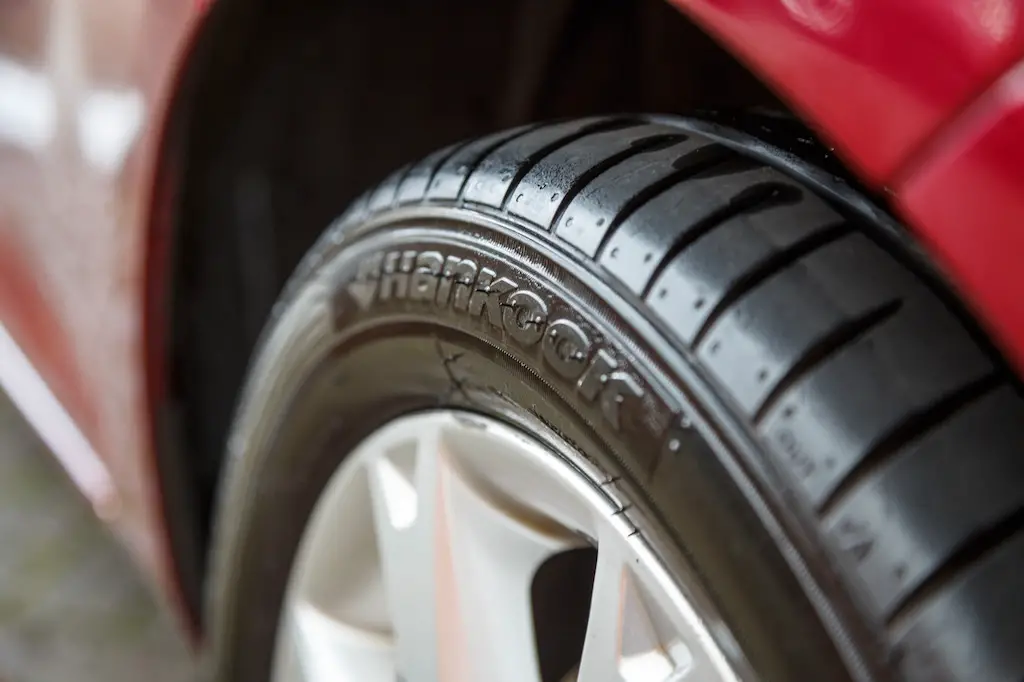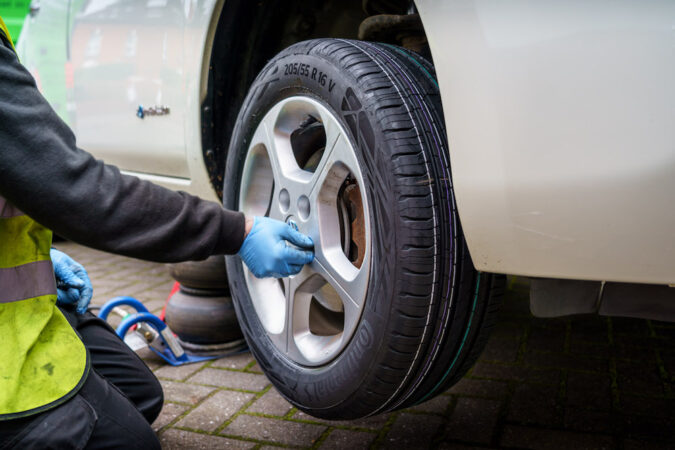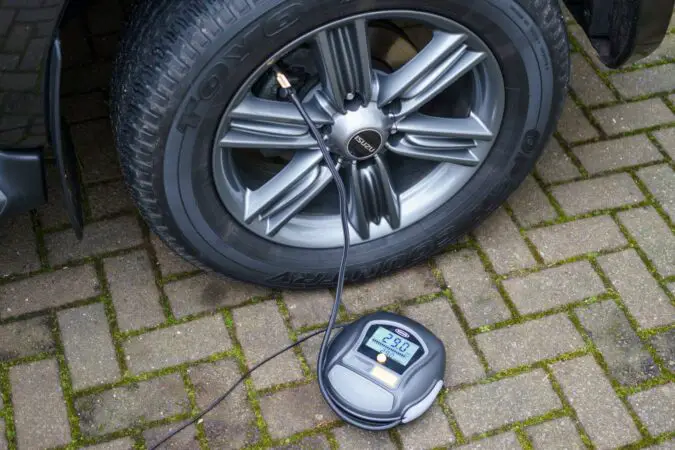A tire pressure sensor, as the name suggests, is a sensor that monitors your tire pressure. Most cars need around 32 to 35 psi of air in their tire to run smoothly and safely. When the tire pressure goes below the normal level, it’s the sensor’s job to alert the driver. Hence, the dangers of what a tire pressure sensor fault can bring.
This is so that the driver knows when they need to pump their tires. Of course, as with any other sensor, the tire pressure sensor can malfunction. We’ll discuss in this post about the tire pressure sensor fault, what you will need to do, replacement costs, and pretty much everything about tire pressure sensors.
- How tire pressure sensors work
- Types of tire pressure sensors
- Tire pressure warning light
- Replacement costs
- Questions & Answers
- Conclusion
- FAQs
TPMS Sensor
A tire pressure sensor is part of a larger component called the Tire Pressure Monitoring System or TPMS. This system is mandatory in all new vehicles sold in the United States since September 2007. The sensor is a small electronic device that monitors your car’s tire pressure.
The sensor then transmits that information to the ECU (Engine Control Unit), typically via low-frequency radio waves. Afterward, your ECU can send a signal and light a warning light if it detects low pressure in one of the tires.
Most tire pressure sensors sit with the tire’s valve stem. Each manufacturer has its own programming, but most will send a warning signal when the tire pressure is 25% below the recommended pressure.
What Does TPMS Mean
As mentioned, the tire pressure sensor system is now mandatory in all vehicles in the US. It’s also mandatory for vehicles sold in the EU since 2012. The reason is pretty straightforward, your car’s tires are obviously important to the car’s operation.
They’re generally very strong, but an incorrect amount of pressure can lead to a blowout and a very nasty accident. This is why a safety feature like the TPMS is necessary, to alert drivers when they have unsafe tire pressure.
Too much pressure on the tires can cause stress and a blowout even when the tires are in a good condition. Meanwhile, low tire pressure will affect performance, and fuel economy, eventually damaging the tires, and can cause a blowout.
As little as a 5 psi difference in your tires can lead to a nasty accident. The TPMS is there to prevent these blowouts by reminding you that your tire pressure is incorrect. When you see an incorrect tire pressure (just like the Tesla Model 3 tire pressure), you can then pull over and pump the tire. Or inspect for punctures just in case there are any.
However, the main reason it was made mandatory was due to the Firestone recall in the late 1990s. Certain Firestone tires were having tire tread-separation issues, which links to more than 100 deaths from rollovers.
This recall pushed the United States Congress to legislate the TREAD Act, mandating the use of TPMS in all vehicles that weighs under 10,000lb. The phase-in started in October 2005, and by late 2007 all-new vehicles came with a TPMS system.
Tire Pressure Sensor Fault: What TPMS Sensor Do I Need
There are only two types of TPMS: direct and indirect, or sometimes dubbed iTPMS. Here’s how they work:
Tire Pressure Sensor Fault, Sensor Types #1: Direct Tire Pressure Monitoring System
A direct TPMS has the sensor mounted to the tire valve in the form of a gauge. As mentioned, this sensor transmits information to your car’s ECU to monitor should there be any loss of pressure. Some TPMS systems can always display the amount of tire pressure the tires have.
This is usually the case for high-end vehicles. This system is very convenient since you can monitor your tire pressure in each tire without even having to get out of the car. Meanwhile, cheaper TPMS will only show a warning light and the driver will need to determine which one actually needs air.
A direct TPMS system is usually more expensive than iTPMS. However, they tend to be more accurate for a reason we will explain in the iTPMS section. They also don’t require resetting after you inflate or rotate your tires.
However, the downside of a TPMS system is that they usually run on its own batteries. This means, that when the battery runs out, you will need to replace them. The good news is that the batteries can last anywhere between 5 – 10 years.
Tire Pressure Sensor Fault, Sensor Types #2: Indirect Tire Pressure Monitoring System
An underinflated tire has a smaller circumference, which means it will rotate faster than a properly inflated tire since they are technically smaller. The indirect tire pressure monitoring system uses your car’s ABS system.
It does so through the wheel-speed sensor to detect if one tire is rotating faster than the other. So, the indirect TPMS isn’t actually monitoring your tire pressure, it monitors the speed of the wheels to determine whether a tire is underinflated or not.
This means that indirect TPMS cannot tell you how much pressure you have in your tires, since they don’t actually measure the pressure. This also makes them less accurate. But they can still tell you which tire is losing pressure, as it can detect which tires are rotating faster.
Another downside to indirect TPMS is that it needs a reset every time you inflate or replace a tire, and when you do a tire rotation. However, the system runs off the car’s electricity and doesn’t need new batteries. Additionally, they are usually quite cheap.
Tire Pressure Light
The tire pressure warning light is usually an amber exclamation mark (!) with curves around it and a flat bottom, signifying a flat tire. If you see this come on, then your car is detecting a flat tire.
As mentioned, an advanced system will be able to tell you which tire is losing pressure and you can immediately check it. But a lower-end system will only have that warning light, and you will need to check each tire to find out which one triggered the warning light.
In any case, it will be a good idea for you to pull over when you see the warning light. DO NOT pull over abruptly. The worst thing you can do when you have a flat tire or a blowout is to brake suddenly.
This will upset the car’s balance and can cause the car to spin out or even roll over. Instead, slowly pull the left lane, let the car coast and apply the brakes very gently. Once you find a safe spot and slowed down enough, you can then stop the car. Tip: do not stop at a narrow shoulder near oncoming traffic.
Afterward, inspect your tires and find out which ones are losing pressure. You can do this by using a tire pressure gauge from Amazon that costs no more than $20. Simply remove the tire valve’s cap, attach the gauge and press it against the valve. Make sure there is no hissing sound and the gauge will take a reading.
Additionally, you should also check for a puncture. If you see a puncture or you can see a tire is physically flat, it’s a good idea to replace them with your spare tire at this point. Continuing to drive with a tire in this state is incredibly dangerous.
How To Change A Flat Tire
I personally am a firm believer that changing a flat tire is a life skill that should be taught at school. Anyway, here’s a quick guide on how to change a flat tire in case you need it:
- Turn on your hazard lights to alert other drivers that you are in an emergency so that they won’t crash into you.
- Apply the parking brake and get out of the car.
- If possible, find bricks or large stones to chock your car to help keep it in place.
- Before you start, it’s a good idea to check your spare tire’s pressure using a tire pressure gauge. They may have lost pressure over the years. If there isn’t enough pressure, you’re going to have to tow your car instead.
- Remove the hubcap or wheel cover (if there are any). Otherwise, loosen the lug nuts counterclockwise until they break resistance. But do not remove them just yet. Your car should come equipped with the appropriate lug wrench.
- Place the jack under the vehicle and start raising the vehicle until the tires are not in contact with the road.
- Unscrew the lug nuts and remove the flat tire.
- Mount the spare tire, reinstall the lug nut and hand-tighten them.
- Lower the car until the tire touches the road then tighten the lug nuts properly with the lug wrench.
- Lower the car completely and remove the jack. Afterward, stow away all equipment and take your flat tire to a tire shop. If you have a puncture, you will need a tire patch.
Here’s a video to help guide you on how to change a tire:
But what if the tire pressure sensor is on and you can’t find a flat or a puncture? Then you may have a tire pressure sensor fault:
What Does Service Tire Monitor System Mean
If your tire pressure warning light is on but your tires are fine, you likely have a TPMS fault. However, verifying this problem may be a bit complicated, but bear with us. You can verify this problem by scanning your car’s OBD system with an OBD reader/scanner.
OBD or On-Board Diagnostics is your car’s computer that registers all error codes in your car when the ECU detects a problem. When it registers an error code, it will light a warning light to alert the driver.
When you scan the OBD, you will be able to see these error codes (if there are any). Generic error codes start with a “P” and usually signify a problem with the powertrain and all cars from all manufacturers use the same code.
For example, all manufacturers use the P0300 error code when there’s an engine misfire. What makes the TPMS diagnostic complicated is that there are no generic codes for them.
Some car manufacturers may use an error code beginning with “C” when there’s a TPMS issue. For example, Nissan uses the C1710 code to signify an issue with the rear right sensor, meaning the rear-right tire pressure sensor is faulty. However, other manufacturers may use this code to signify something else, or they may not have an error code in the first place.
How To Use An OBD Scanner
If you have a more advanced TPMS system, then it can display your tire pressure sensor on the dashboard or the center screen in the car. If any of the pressure reads zero psi but the tire is fine, then you know which sensor is faulty.
However, if you don’t have this advanced system, you will need to do an OBD scanning. While your car may not have an error code for a faulty tire pressure sensor, the good news is that you can easily find out online. Then you can crosscheck this with the error codes you see in the OBD scanner.
Keep in mind that there are two types of OBD; OBD1 was used in cars made before 1996, and every car since then uses an OBD2 system. Make sure you get the correct scanner for your car. Here’s how to use them:
- Plug the reader into the car’s OBD port. This port is often located underneath the dashboard area, either above your pedals or knee. Keep in mind that some cars might have their port hidden out of sight. Check your owner’s manual or online to see where it’s located in your car.
- Once plugged in, turn on the OBD scanner. It should immediately scan the car. However, some scanners might require you to input additional information such as make, model year, VIN number, etc.
- It will then display the error codes it has found. A more complicated scanner might also display a description of what’s wrong with the car.
There are also Bluetooth OBD scanners that can take more detailed readings by using an app on your smartphone. Check out this video from Motorvate DIY showing how he used the Fusion OBD to detect a tire pressure sensor fault:
What Can Cause A Tire Pressure Light To Come On
Tire pressure sensors typically fail simply because of age. As mentioned, a direct TPMS system runs off an auxiliary battery that will die within 5 – 10 years. If your car is around this age, it’s likely the battery has run out. If you have an indirect TPMS in your car, then it’s possible you have a faulty wheel speed sensor since that’s what the system uses to monitor your tires.
Other reasons might include corrosion, wiring issues, and TPMS module failure. In any case, it’s best to address the issue so that your car’s tire pressure monitoring system can keep running and help to keep you safe.
Tire Pressure Sensor Replacement Cost
An indirect TPMS uses the wheel speed sensor and a module to monitor the tire’s condition. If the fault lies with the module, then it should cost you no more than $25 to replace it. However, if the problem stems from the speed sensor, then you’re looking at a repair bill as high as $290 or higher, including labor.
Meanwhile, a direct TPMS means that it has a sensor on each tire that monitors the tire pressure. These sensors will cost anywhere between $50 – $250 each, depending on their complexity. Needless to say, the cost for a tire pressure sensor in a luxury car will be on the higher end of the spectrum.
Tire Pressure Sensor Fault: Other Considerations
Do I Need To Replace TPMS When Replacing Tires
No, as mentioned, an indirect TPMS uses the vehicle speed sensor in the ABS system to monitor tire irregularities. We’ve covered this in more detail in our guide on the Toyota P0500 code. So the sensor isn’t in the tires themselves. However, they may require a reset and recalibration when you fit new tires or do a tire rotation. Any good mechanic in a decent auto repair shop should be able to do this.
Meanwhile, the direct TPMS uses a sensor that sits with the tire valve which is actually part of your car’s wheels. So when you change the tire (after learning how to change a tire on a car), it doesn’t actually affect the sensor and you don’t need new sensors.
Most of the time direct TPMS also doesn’t require recalibration when you get new tires. However, if you’re getting new wheels for your car then you will need to make sure whether or not it has TPMS and whether there are any setups required.
Do You Need TPMS Sensors
There isn’t any clear information online for those driving older vehicles. The TREAD Act simply states that all new vehicles from September 2007 have to come equipped with a tire pressure monitoring system, but it doesn’t say that older cars have to be fitted with one.
The Department of Transportation also states that it’s illegal for an auto shop to install tires without working TPMS on any car that originally had it, but it doesn’t say anything about cars that didn’t have the system in the first place.
As far as we can see, it isn’t your responsibility to install TPMS should your car not have it in the first place. However, in some states, a car may not pass an inspection if it doesn’t have a functioning TPMS system.
Meanwhile, in some states, you can sell a car without a functioning TPMS, but the new owner may not be able to register it. Keep in mind that this usually only applies to cars that should have had TPMS in the first place.
If you’re concerned about whether or not you should have a TPMS in your car, check with your local DMV or lawyer. The laws may differ from one state to another, so it’s best to make sure. In any case, there’s really no harm in installing an aftermarket TPMS. It will help monitor your tire pressure and keep you safe.
For more comprehensive information about TPMS, read our article here.
Should I Get Run Flat Tires
A run-flat tire is a pneumatic tire that can resist the effect of deflation when punctured, allowing you to continue driving at lower speeds for a limited distance, usually up to about 50 miles.
There are several types of run-flat tires, some have a supporting inner lining, and others have self-sealing technology. But they all will allow the driver to continue driving – albeit at a limited speed – even when they have a flat tire.
Run-flats were actually part of the reason why TPMS is mandatory. This is because drivers may not notice that they have a flat tire when they use run-flat tires. The TPMS is there to alert the driver that they have a flat tire so that they will slow down to the appropriate speed and look for the nearest tire shop to get it fixed.
Run-flat tires are very convenient, and there’s almost no downside. The only real downside to run-flat tires is that they can be uncomfortable compared to normal tires. The inner linings are designed to be hard and support the car’s weight after all. They are especially uncomfortable over potholes and speed bumps.
I personally am not a big fan of run-flat tires. But they will free you from the hassle of changing a flat tire when you have one. If you’re willing to trade comfort for this convenience, then by all means you should get run-flats. Keep in mind that they may be a bit more expensive than standard tires.
Tire Pressure Sensor Fault: Wrap Up
The tire pressure sensor isn’t a crucial component in your car. Your car will run just fine even if the TPMS is faulty, or even without it. However, it has since been mandatory in all new cars sold in the United States since 2007. It’s a safety device that helps to prevent tire-related accidents.
Tire pressure sensor fault is relatively uncommon, but it may happen after about five years. If you see a tire pressure sensor fault, using an OBD scanner may help to find out which tire pressure sensor needs replacing. It’s usually quite cheap, at around $50 per sensor for most cars.
If you drive an older car and don’t have TPMS onboard, there’s no need to worry as it isn’t really our responsibility to fit one in a vehicle that didn’t originally have it. However, just to be sure, check with your local DMV on whether or not it’s mandatory for your car to pass an inspection.
An aftermarket TPMS should cost no more than $200, depending on your vehicle’s make and model and what type of TPMS you’re getting.
FAQs On Tire Pressure Sensor Fault
If you’re still curious to learn more about the tire pressure sensor fault, our FAQs here might help…
How To Reset Tire Pressure Light
Ordinarily, the tire pressure light will require a manual reset once you’ve inflated your tires after driving with low air pressure for too long. This is caused by your car’s TPMS sensor no longer being calibrated properly after that tire pressure differential. Resetting the tire pressure sensor light does vary from one car to another. Generally, the steps are familiar… First, you’ll have to make sure that the tires are properly inflated at the recommended PSI. Then, you’ll need to start up your car and press the TPMS reset button. After pressing and holding this button, the tire pressure sensor light will blink. At which point, go for a 30 or so minute drive at around 50mph. This should allow the TPMS sensor to properly re-calibrate themselves again.
Where Is The TPMS Reset Button
If you need to reset and turn off a tire pressure warning light, you’ll usually need to manually press a TPMS (tire pressure monitoring system) reset button. In most cars, it can be found somewhere underneath the steering wheel and around the steering column. This button might show a symbol akin to tire treads on the ground, with a circle in the middle, and two arrows pointing at it from either side. Plus, this button might also show a large SET text to indicate its purpose – doing a hard reset on the TPMS sensor. It’s wise to check the owner’s manual to properly determine the exact location of the TPMS reset button, though. In some cars, this button might be located elsewhere, usually somewhere hidden and somewhat out of sight.
Why Is My Tire Pressure Light Blinking
One of the warning lights that might appear on your dashboard is the tire pressure light. This particular warning light has two states – either it lights up and stays on, or it begins blinking/flashing repeatedly. If the light remains solid and is constantly lit up, then it’s an indicator that one or more of your tires are underinflated. In that case, it’s a good idea to have your tires checked and inflated, if necessary. However, if that same warning light blinks, it’s usually telling you that the TPMS sensor itself isn’t working properly. It’s possible that the sensor isn’t sending the right data back to your car. Or, perhaps the sensor has died altogether, has a weak battery, or has entirely gone missing. So, be sure to give those TPMS sensors a check-up.
Where Are The Tire Pressure Sensors Located
Seeing that the tire pressure sensors (TPMS) have to monitor your tire’s PSI levels, it naturally has to be located near or around the tires. Most of the time, you can find the tire pressure sensors mounted on the inside of a tire. Specifically, on the inner rim of the tire, in the small void between the tire and the rims/wheels/alloys. If you were to remove the tire and look at the rim, you can usually see a small cylindrical device. This is the TPMS sensor. However, this placement isn’t always fixed. In some cars, the TPMS sensors might be located on the valve stems. The same goes for aftermarket TPMS kits, which are usually installed outside of the tire instead of within it. Although, a good set of TPMS sensors should be accurate, irrespective of its location.
How To Fix Low Tire Pressure
If your tire’s air pressure is too low, the first thing you should do is refill it with some air. Re-inflating it won’t just ensure that your tires aren’t undergoing excess strain, but it’s better for your car’s performance, and allow you to grip more securely onto the road. The latter is crucial for your safety. However, if your tire pressure keeps dropping afterward, you might need to consider visiting a tire shop. If your tires are too old, they can introduce small leaks that let the air out. In this case, you should consider replacing your old tires. Or, it might be leaking air due to a puncture, which can be repaired depending on how severe the damage is. Otherwise, your wheels/rims might be bent, in which case they too could be repaired, if the damage isn’t too bad.






